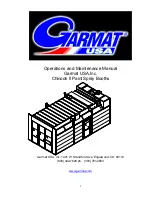
126
Medfusion® Model 3500 pump V6
Operator’s Manual
(Motor Drive Phase A/B POST, the ability for the
watchdog to stop the motor (Motor Drive off POST).
Periodically during pump operations the software
checks motor operation in background. Motor
background checks include the stopping of the motor
when an infusion stops and the motor supply voltage
test.
If a motor POST or background check fails the
pump will display a system fault screen, turn on
a continuous two-tone audible alarm, flash the
backlight and stop all drug delivery.
If the Motor shaft fails to complete the first shaft
rotation (Motor Not Running) or a subsequent shaft
rotation (Motor Rate Error) with the expected timing
the pump will display a high priority alarm, turn
on a continuous two-tone audible alarm, flash the
backlight and stop all drug delivery.
When the pump is powered on with a depleted
battery and no AC power, this alarm may sound due
to the low battery state. Recharge the battery, turn the
pump on, turn the pump off, then turn the pump on
to clear the condition.
Keyboard Encoder Check - Control key POST or
BGND
Every time the software receives data from the
keyboard encoder, it is checked. If the data is not a
valid key press, the software will disregard the key
press.
Data Handling Software Safety
Features
Data Stored in EEPROM - Critical data POST or
EEPROM timeout or Primary/Secondary critical
data corrupted
Before use, data associated with delivery and stored in
EEPROM is tested by calculating a CRC on the data
and then comparing it with the CRC stored with the
data. If the EEPROM timeout occurs or EEPROM
Primary and Secondary stored and calculated CRCs
do not match, the software will display a system fault
screen, turn on a continuous two-tone audible alarm,
and stop all drug delivery.
Data Used in Calculations - Critical data failure
Calculations on data used in some way to control the
Safety Features
Safety Features and Fault
Detection
Hardware Safety Features
A watchdog circuit, made up of a separate
microcontroller with a dedicated timer, alarm
speaker, and power supply, monitors the main
microprocessor and associated electronics. The
purpose of this circuit is to detect failures of the
system including power, electronics and software,
and generate an alarm if one is detected. If a failure is
detected, a watchdog or “SYSTEM FAILURE” alarm
will be generated through the dedicated speaker,
the red alarm indicator will be turned on, and the
pumping mechanism will be disabled. Some watchdog
failures (for example, one that may occur rarely when
powering down following a Configuration update)
may be cleared by cycling power on the pump.
Software Safety Features
Hardware-related Software Safety Features
Program Memory - Check FLASH memory POST
or BGND
At power up and at regular intervals thereafter, the
program memory is tested by calculating a Cyclic
Redundancy Code (CRC) on the program and then
comparing it with the CRC stored with the program.
If the stored and calculated CRCs do not match, the
software will display a system fault screen, turn on a
continuous audible alarm, and stop all drug delivery.
RAM Memory Check - RAM BGND
During operation, the random access memory is
checked. A series of bit patterns is written to and read
from the RAM. If the read data is different from the
written data, the software will display a system fault
screen, turn on a continuous alarm, and stop all drug
delivery.
Motor Circuit Check - pump motor phase A or B
POST and Motor rate error during operation
At power up the pump performs power on self test
(POST) checks of the motor. Motor POST checks
include the ability to drive current to the motor
Содержание Medfusion 3500
Страница 151: ......
















































